I hope it's expensive.
Yes very. What would be the reaction if John made a phono stage this bad? Perfect mate for the Wavac, are there speakers in this category?
Last edited:
What would be the reaction if John made a phono stage this bad?
I can't imagine that he'd let something that bad be released with his name associated with it. I just do this stuff for fun and have no engineering training, and *I* would be embarrassed by that.
The Gibbs phenom has Conditions associated with Sampling and discontinuities. . If the Tr (or BW) exceeds the systems response,a discontinuity exists for the Gibb condition. Slower than those conditions, you dont get the ringing.
https://books.google.com/books?id=x...itions for Gibbs phenomenon to exist?&f=false
The rule of thumb for Gaussian response - the .35 Tr = BW applies to a given transient signal shape.... fastest Tr without over-shoot. The filter I made isnt that but never the less, the HF roll-off must be at or near the Gibbs condition; Basically lower BW than the system. Greater or too fast tr and you have the conditions for Gibbs. Recall I added the analog LCR filter to the ADC input also and used the same process with same results at playback output with no added LCR filter on the output.
So you are close enough for an answere to your question. I can watch the affect in real time as I changed the Tr time.... sliding across... from max ripple to min. I chose the point of filtering and slope of that filter to also align with the HF noise as it rises up from the first (brick-wall) filter null and ripple starts rising again.
Its all very cleaned up and clear sounding. It may need some fine tuning to get optimum results. But it works very well as it is.
THx-RNMarsh
https://books.google.com/books?id=x...itions for Gibbs phenomenon to exist?&f=false
The rule of thumb for Gaussian response - the .35 Tr = BW applies to a given transient signal shape.... fastest Tr without over-shoot. The filter I made isnt that but never the less, the HF roll-off must be at or near the Gibbs condition; Basically lower BW than the system. Greater or too fast tr and you have the conditions for Gibbs. Recall I added the analog LCR filter to the ADC input also and used the same process with same results at playback output with no added LCR filter on the output.
So you are close enough for an answere to your question. I can watch the affect in real time as I changed the Tr time.... sliding across... from max ripple to min. I chose the point of filtering and slope of that filter to also align with the HF noise as it rises up from the first (brick-wall) filter null and ripple starts rising again.
Its all very cleaned up and clear sounding. It may need some fine tuning to get optimum results. But it works very well as it is.
THx-RNMarsh
Last edited:
\
The rule of thumb for Gaussian response - the .35 Tr = BW applies to a given signal shape. The filter I made isnt that but never the less, the HF roll-off must be at or near the Gibbs condition; Basically lower BW than the system. Greater or too fast tr and you have the conditions for Gibbs.
Dick you're not answering the question, the square wave you posted is filtered at 10kHz, the tr/BW relationship changes only a few percent over filter type. This is just math, and please don't try and tell me you are facile with the level of math in that reference.
I have friends that "fix" their CD players with a single R/C at 10kHz, it's OK by me. I have a film reference for "It's OK really it's OK" but it is too obscure for this audience.
Last edited:
What about trying filters with less poles, to find if there is a better compromise ?Its all very cleaned up and clear sounding. It may need some fine tuning to get optimum results. But it works very well as it is.
Less poles gave more ripple and less HF rejection.... the main goal. I can dial back the filter to be closer to 20KHz and see how that works. It sure sound better without the Hf and ringing.... if I can sqeeze some more BW out of it without letting in significant HF, I'll do it.
Too bad we have 44.Khz to deal with. Would direct downloads of 24/96 help make it easier to get all the 20KHz? Like the HD downloads.
THx-RNMarsh
Too bad we have 44.Khz to deal with. Would direct downloads of 24/96 help make it easier to get all the 20KHz? Like the HD downloads.
THx-RNMarsh
Of course, on a pure "visusal" point of view. But what about the impact on a given amplifier ? This ripple is at a frequency we can't hear. I believe it is all about how the amp is able to deal with.Less poles gave more ripple and less HF rejection....
, and please don't try and tell me you are facile with the level of math in that reference.
I asked the question (Google) about What are the Conditions for Gibbs. This site gives it about mid way down. Look for it. But there are other sites which attempt to answer my question also. Most are not this dense. But check for yourselves as to what the conditions are the creates the Gibbs. Dont exceed those conditions and you dont have any Gibb affect. I only need to creep up on the system BW but not exceed it with signal/filter.
As good as my experiment sounds.... not much music above 10KHz .... it can only sound better getting closer. And, maybe flatter as well. It was a shock to see all that HF and now that its gone, it very very good. So, there is an interaction with the amp the player feeds having HF with the audio.
Now I will measure the filter combo insitu and see where it Really is. But, we are not going to be better than that brick wall filter for Tr/BW. In the scope photos... both before and after have Tr of close to 50uSec.
Because I measured LCR and showed it on the A-P as much higher than 20KHz. So, it shouldnt have that much affect on the total Tr's/BW. In fact if you look at the time scale... they are both near 50usec to scope tolerance.
You remember why I am doing this, right? To answer the question of why do direct master HD 24/96+ downloads sound better than 16/44?
I am closing in on that. 🙂
THx-RNMarsh
Last edited:
cant edit any more...
Why does direct 24/96+ HD downloads sound better than 16/44 CD's.
That is what i am closing in on for an answer. .
Thx-RNMarsh
Why does direct 24/96+ HD downloads sound better than 16/44 CD's.
That is what i am closing in on for an answer. .
Thx-RNMarsh
Last edited:
Refresh by periodically clicking the 'Preview Post' button.cant edit any more...
The increased time and amplitude resolution/precision of 24/96+ .....Duh 😉Why does direct 24/96+ HD downloads sound better than 16/44 CD's. That is what i am closing in on for an answer.
I find more importantly is the nature of the DA reconstruction/filtering noise artifacts/remnants and downstream consequentials, as you are documenting.
Dan.
Last edited:
I believe for the same reasons that 76cm/s analog tapes sounded better than traditional 38.? Phases in the audio bandwidth ? No or slow slopes close to our frequency listening limit ?Why does direct 24/96+ HD downloads sound better than 16/44 CD's.
A more easy way to understand the phenomena is to think about numeric photography using Bayer filter technology. As long as the resolution of the sensor is under the one of the optic (In audio, microphone + HF musical instruments contents), you need this brick wall filter (Anti Alias filter in photography, introducing additional blur).
If you reduce the size of the "pixel" in such a way that it will be smaller than the "circle of confusion", you don't need this AA filter anymore to avoid those boring fringes.
Looking at a wave form, the number of bits represent the precision on the vertical scale, the sampling rate, the horizontal one.
Well, it isnt so hard to test the filter to/thru the BenchMark -- it is the BenchMark analog input which terminates the passive filter we are working with. The CD player output thru the filter to the linear amp to its output --- and basically the HF filter follows the A-P curve, I showed;
I have set the line stage of the Markbench-2 to be +3dB at 1KHz on the analyzer display (just using its volt meter capability for this test.
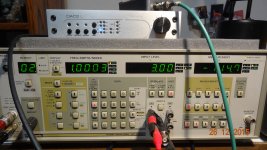
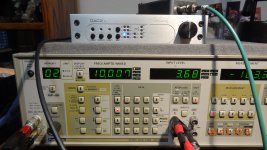
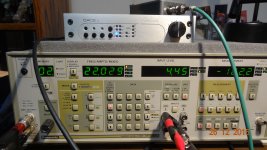
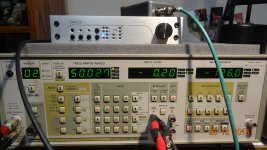
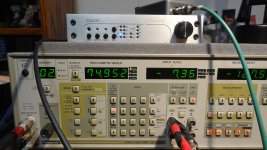
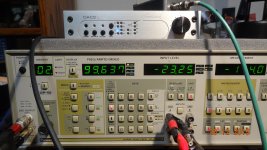
More tests to do......
[Click your pointer on a picture to expand it.]
TH-RNMarsh
I have set the line stage of the Markbench-2 to be +3dB at 1KHz on the analyzer display (just using its volt meter capability for this test.






More tests to do......
[Click your pointer on a picture to expand it.]
TH-RNMarsh
Last edited:
and basically the HF filter follows the A-P curve, I showed;
I have set the line stage of the Markbench-2 to be +3dB at 1KHz on the analyzer display (just using its volt meter capability for this test.
View attachment 521234
TH-RNMarsh
The Tr of the DAC is 50usec and the Tr of the post filter is 20usec. Combining ---- sq rt of sum of sq = 18.6KHz. With 5% caps and 10% inductors it is close enough for government work, as we say. If in production - I could use 1-2% parts and or slightly different value. But, it doesnt matter for where i am going with this.
THx-RNMarsh
Last edited:
cant edit any more...
Why does direct 24/96+ HD downloads sound better than 16/44 CD's.
That is what i am closing in on for an answer. .
Thx-RNMarsh
Two words: sighted evaluation. Throw out objectivity and technology is prone to turn into chaos.
Two words: sighted evaluation.
Possible, but a necessary condition to do an actual comparison is having the masters be identical- and of course, level-matching. It is not uncommon for different formats to be mastered differently.
But controlling variables is the stuff serious researchers do. You're not going to get that from faith-based folk.
Possible, but a necessary condition to do an actual comparison is having the masters be identical- and of course, level-matching. It is not uncommon for different formats to be mastered differently.
Of course I totally agree with that. When I say "Sighted evaluation" I really mean the whole naive amateur approach to comparing audio gear by ear - the sighted listening, the absence of level matching, the absence of time synchronization, the absence of relevant measurements of what the actual difference is, the absence of confirmation that the gear is all working right, etc., etc.
But controlling variables is the stuff serious researchers do. You're not going to get that from faith-based folk.
Right. The audio sound quality train got derailed many decades ago when the gear was so bad that naive testing actually made some sense. Very few people upped their game when the gear got to be a whole lot better.
Meaning exactly what?
Meaning my objection to the “badly engineered”.
The design decisions were intentional, steered by ‘listening impressions’.
The linked (long) presentation gears around the “internal-model–based view of perception”
“Perhaps some of things we discard as audio engineers bear further examination when it comes to the perception of music.”
George
Because I measured LCR and showed it on the A-P as much higher than 20KHz. So, it shouldnt have that much affect on the total Tr's/BW. In fact if you look at the time scale... they are both near 50usec to scope tolerance.
You remember why I am doing this, right? To answer the question of why do direct master HD 24/96+ downloads sound better than 16/44?
I am closing in on that. 🙂
Your scope rats you out, the rise time reading to three digits is 35usec plus/minus. You are doing something in your process that is starting to affect the signal at 10kHz or even lower. You are not the first person that prefers digital with the treble turned down.
On the second point, there is a large body of evidence to the contrary certainly if you stick to the anecdotal. You have said before that DBT, for you, is a waste of time so this will go nowhere.
- Status
- Not open for further replies.
- Home
- Member Areas
- The Lounge
- John Curl's Blowtorch preamplifier part II